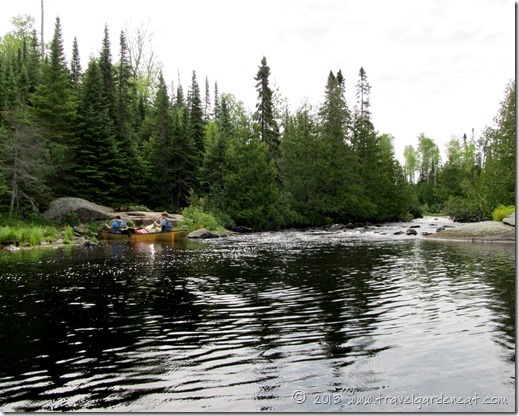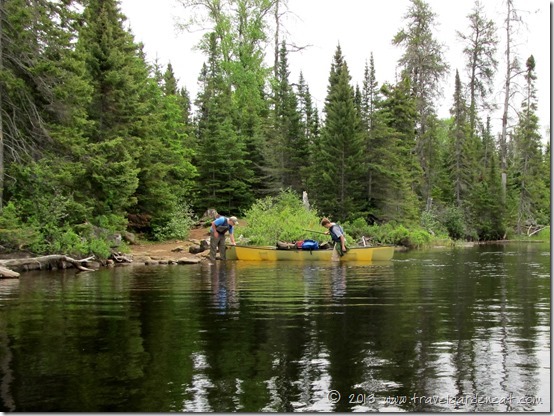Turning off the cell phone and leaving it behind for four nights is a liberating feeling. Once we were up the Gunflint Trail, cell phone signals were no more. Problem-solving while camping and on the water in the BWCA would be handled through good old-fashioned brain power rather than plugging the query into Google. No email, text, Facebook message, or other digital note required immediate attention. Video games, Netflix and other screen pursuits could not compete for family time and attention.
The Boundary Waters Canoe Area Wilderness (BWCA) is a special area comprising over 1 million acres of lakes, rivers, streams and forests located in northern Minnesota’s Superior National Forest. The U.S. Forest Service describes perfectly the appeal of this region:
Wilderness offers freedom to those who wish to pursue an experience of expansive solitude, challenge and personal integration with nature. Because this area was set aside in 1926 to preserve its primitive character and made a part of the National Wilderness Preservation System in 1964, it allows visitors to canoe, portage and camp in the spirit of the French Voyageurs of 200 years ago.
Hungry Jack Outfitters shuttled us to our entry point, along with the two canoes, four personal packs, two equipment packs and one food pack that contained all we would need for the next three nights. We put in at the Cross River, working our way to the formal Cross Bay Lake entry point, still three portages away. As I explained in Part 1, entry to the BWCA from May through September is controlled by quota permits to specific entry points. Some entry point permits allow motor use, others permit paddle only. Some permits provide for day use while others are for overnight access.
Portages are paths on land connecting bodies of water. A portage is measured in rods, with each rod equal to approximately 16.5 feet or 5 meters. The length is not as significant as the terrain — wet conditions can make for slippery rocks and muddy paths, with uneven footing or elevation changes adding to the challenge. And, regardless of the length or terrain, each portage means unloading and reloading the canoes, with two of us portaging the canoes, two of us portaging one or two packs each (one strapped to our back and the other carried on our front), and then always a second trip back on the portage trail by one or two of us to pick up at least one pack that remained.
Our permit provided for overnight paddle use via the Cross Bay Lake entry point — the red circled “50” on the map. The starting point for the trip was northwest of the entry point, with a short paddle down the Cross River, and two portages (approximately 50-rod and 40-rod) to Ham Lake, followed by a short 24-rod portage to Cross Bay Lake. Our goal for the first day was to reach and set up camp on one of the island campsites on Long Island Lake, another four portages beyond the entry point.
Many portages are located next to small waterfalls or fast-moving streams of water. They are marked on the maps with a number indicating the rod length of the portage, but some require an eagle eye to spot as you work your way across a lake toward the suspected location of the portage. The entry and exit points of several portages we navigated during our first day on the water were quite rocky, and required careful maneuvering as we approached them to avoid scraping the canoes we were paddling.
The Kevlar canoes that Hungry Jack Outfitters provided as part of our outfitting package were wonderfully light — I have no great upper body strength to write home about and yet I could quite easily hoist the 45-pound canoe without assistance, lowering the padded yoke onto my shoulders while lightly holding the sides to maintain the canoe’s balance as I walked down the trail.
With each portage, our efficiency increased. On our third portage, we were formally welcomed to the BWCA! I pulled out my camera and announced a photo was needed as my husband portaged our canoe. The muttering I could hear coming from under the canoe was a clear refusal to slow and become an even-more-appealing target for the mosquitoes which swarmed heavily on the protected portage trails.
When I wasn’t helping pilot through shallow waterways, I would periodically announce my intention to set down the paddle and snap a few photos, pulling my camera from the watertight dry bag I used as a camera bag for the trip. We drifted past towering rugged walls of rock, with my husband keeping the canoe on course from the stern. I could easily have slowed our relaxed pace even further, just taking in the quiet scenery. My peaceful photographic sojourn ended each time when an impatient voice from the back of the canoe asked if I was planning to pick up my paddle again sometime soon.
Due to the unpredictable rainy weather conditions, we wanted to push on to our destination — a campsite on Long Island Lake. We crossed paths at one of the portages with another group returning from that lake and they assured us the lake was virtually empty and we would have our pick of campsites!
The sky remained dark with heavy clouds, and the winds worked against us on many of the open waterways. The rain clouds spit on and off, but we thankfully did not meet with any lightning that forced us off the lakes. We paddled on, finding our rhythm of traveling together on the water.
Rather than stopping for a shore lunch of sandwiches, we pulled out the snack bag from the food pack and selected a quick energy granola bar or candy bar to tide us over. As we drew close to our final stopping point for the day, the boys were almost out of sight by the time we finished loading our canoe and hit the water again.
Ciao! ~ Kat
Other posts in this series:
Coming soon: Part 3, Our Island Home










22 responses to “Unplugged and Off-the-Grid: Getting our Paddles Wet (Part 2)”
[…] Getting Our Paddles Wet (Part 2) […]
LikeLike
[…] Getting Our Paddles Wet (Part 2) […]
LikeLike
[…] Getting Our Paddles Wet (Part 2) […]
LikeLike
[…] Getting Our Paddles Wet (Part 2) […]
LikeLike
[…] Getting Our Paddles Wet (Part 2) […]
LikeLike
What a beautiful place to be. Your photographs are wonderful.
LikeLike
Appreciate the comment, tinywhite — it is unfortunate our days were all so gray, because the beauty is showcased so differently when that blue sky frames it!
LikeLike
Sounds and looks fantastic! Thanks for taking us along. 🙂
LikeLike
Thanks for tagging along with me!
LikeLike
So pure and beautiful!
LikeLike
Pure is such a good word for it. Very few places like it.
LikeLike
So beautiful wilderness! It was a wonderful to read about your family adventure!
LikeLike
Thanks Tiny — the blog posts are a fun way to reflect back on the trip.
LikeLike
[…] Coming soon: Part 2, Getting Our Paddles Wet […]
LikeLike
I consider myself an urban gal…but your post and series are really making me wanna get out there in the wilderness and canoe over to the next spot…wow, you live in a beautiful state!
LikeLike
We feel so fortunate to have so many wonderful nooks and crannies to explore so close to home! You definitely need to experience it some day.
LikeLike
Gorgeous trip photos, Kat. Minnesota is such an under-rated outdoorsy state.
LikeLike
Having lived in Colorado for undergrad, I can say they are both wonderfully outdoorsy states, but each with their own flavor.
LikeLike
Wonderful photos, Kat! It’s been about 3 decades since I camped up that direction. It’s still just as beautiful and pristine as I remember.
LikeLike
The wonderful thing about it is that it is likely little has changed despite the passage of time (other than unfortunate changes like fire).
LikeLike
Fun to read about your trip; great photos!
LikeLike
It was too short, but still a nice getaway.
LikeLike